Letov S-16.1 Prague-Tokyo-Prague 1927
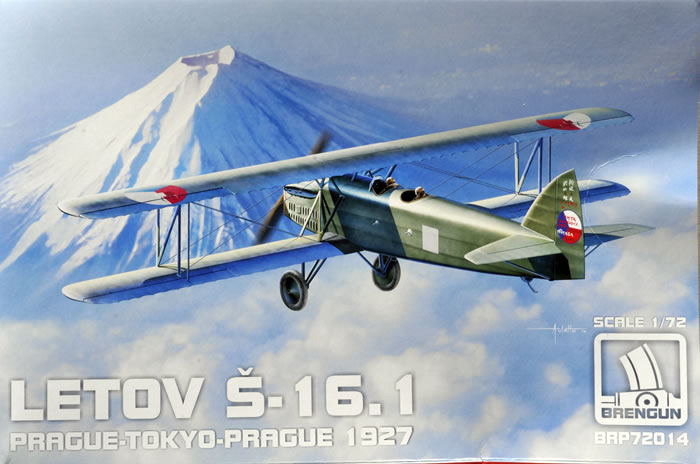
Brengun, 1/72 scale
S u m m a r y : |
Catalogue Number: |
Brengun Kit No. BRP72014 - Letov S-16.1 Prague-Tokyo-Prague 1927 |
Scale: |
1/72 |
Contents & Media: |
81 tan styrene parts, a PE fret of 17 parts, an acetate film, and decals for two subjects. |
Price: |
Available on-line from these stockists:
For currency conversion click here |
Review Type: |
First Look. |
Advantages: |
Good quality components, nice detail, and best injected S-16 kit in this scale. |
Disadvantages: |
None noted. |
Conclusion: |
This is a welcome kit of an important Czechoslovak type. I am sure we will see it in further boxings, obviously as a bomber and reconnaissance machine in Czechoslovak markings, and perhaps Latvian and Turkish insignia too. This boxing is surely pitched mainly at the domestic Czech market, and a degree of cynicism suggests to me that Brengun aims to capture sales from those too impatient to wait for the military-service boxings, and so amortise some of this boxing’s production costs across a group not interested in the Prague to Tokyo flight.
Whatever the marketing rationale is behind it, the fact remains that Brengun’s S-16 is very well executed, with excellent quality parts for a limited run kit. So much so that I feel the term “limited-run” has little meaning here. It has without doubt bettered the old and faithful offering by Kovozávody Prostejov (and KP Models/Mastercraft). As such, it is best injected kit of the Letov S-16 in The One True Scale.
I definitely recommend this kit, and look forward to future issues covering other versions. |
Reviewed by
Mark Davies

Sword's 1/72 scale Ki 44 Shoki is available online from
Squadron.com
I found it difficult to find much information on the Letov S-16, in English at least. The following is my interpretation of a less than satisfactory translation of a Czech web-based account.
The design of a long-range light-bomber and reconnaissance type that led to the S-16 originated in 1924. (A heavy escort-fighter role may have been considered too, but I am unsure on my interpretation of source material here.)
The first prototype, a private venture, first flew in November 1926 and was exhibited at the Paris Salon de l’Aeronautique in December of the same year. The Czechoslovak Ministry of Defence (Ministerstvo národní obrany or MNO) subsequently ordered three prototypes for testing. Meanwhile, Latvia placed an order for twenty-one S-16L aircraft, with deliveries commencing in 1927. Turkey ordered twelve S-16T machines during 1930-31.
Letov staged a demonstration flight of the S-16 over 23,000 km from Prague to Tokyo during August and September of 1927. The trip was truly groundbreaking and involved all manner of trials and tribulations as the plane transited various countries. However, the return trip did not finish because of radiator issues, and the plane returned to Prague by train! Meanwhile the MNO continued testing prototypes until generally satisfied with the outcome in May 1928. It ordered six more aircraft for further competitive testing against the Aero A-30, which was also being evaluated.
Finally, the S-16 was accepted for service with the Czechoslovak Air Force. Production of the main series occurred over three years, with fifteen airframes being produced in 1929, fifty-two in 1930, and twenty-two in 1932. The type was used by all the six founding aviation regiments, and served reliably in the second half of the 1930’s when it was declared obsolete and replaced by the Aero 100. However, thirty-one S-16’s were still in service during the 1938 mobilization in response to the German-sponsored Sudenten crisis.
Several other variants were derived from the basic S-16. These included the S-16J developed for Yugoslavia, a floatplane using Dornier floats. However, it seems there were problems with the floats corroding and Yugoslavia lost interest, having purchased only one machine.
Previous 1/72 scale Letov S-16 Kits
The only injected 1/72 scale S-16 kit I am aware of dates from 1982 by Kovozávody Prostejov*, a communist Czechoslovak entity. The same kit has since been re-boxed by KP Models (a private Czech company) and Mastercraft of Poland. This is by a far the most common S-16 kit, and is generally quite a good one, although it is now beginning to show its age.
On checking my records I also see that AB Models have issued several resin kits, an S-16 prototype, Turkish S-16T, and several S-16 derivatives (S-416, S-516 & S-816). Omega Models have also done some versions, including the S-16J floatplane and S-316 derivative, again in resin. Finally, Blackbird models have issued an S-16T, which I presume was resin also. I am unfamiliar with any of these resin kits, so I cannot comment further.
* Petr Muzikant of AZ Models has since registered the Kovozávody Prostejov brand name for the first time, so the name is now in private hands. It is being used to brand a new range of kits such as the S.199 and S.20L. However, the newly registered brand has nothing to do with the communist-era kits, the tooling for which is under different ownership.
Contents
The kit comes in a rather large box for a single-engine plane in this scale. It has artwork showing the Prague-to-Tokyo S-16 approaching what I assume is Mount Fujiyama, as this particular boxing is dedicated to the Prague-Tokyo-Prague flight made by Lt.Col. Jaroslav Skala and his mechanic Matej Taufer.
Two sprues of light-brown plastic and a resin propeller are contained in a re-sealable cellophane plastic bag, along with a further small cellophane bag enclosing a clear acetate film, decals, and a small PE fret. The parts are limited-run but unlike some Brengun kits, this one had no noticeable flash; the parts all appear very clean and crisply moulded.
The optional resin propeller is cleanly cast, and the PE fret is of similar good quality.
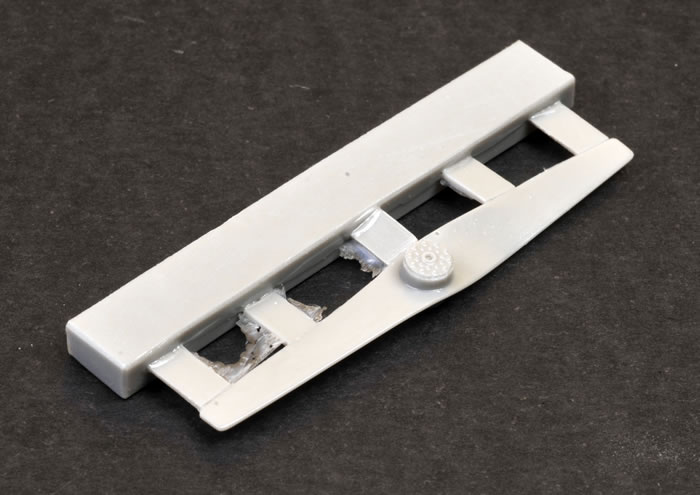
The acetate film has windscreen outlines printed to guide cutting out these parts. The decals are well printed with good registration and seemingly good colour density.
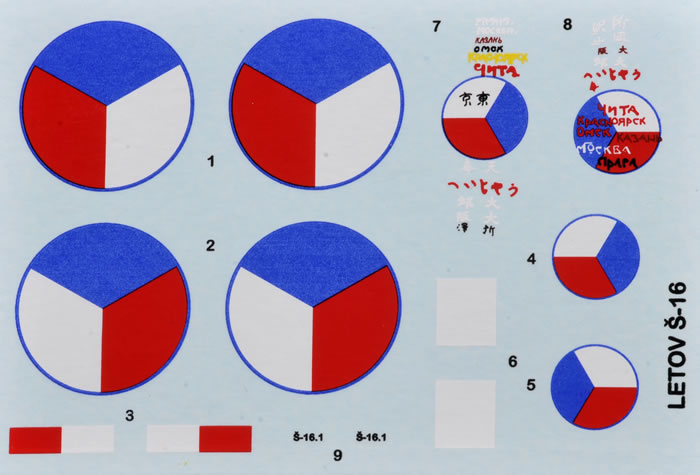
There is a second errata sheet provide for the rudder markings however.
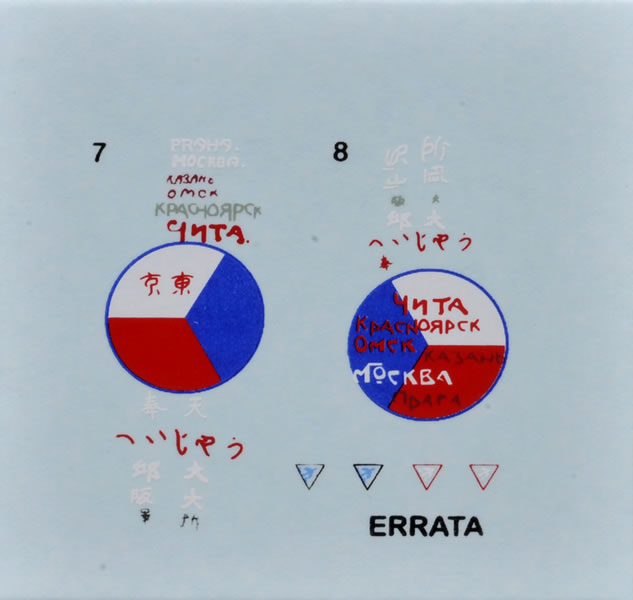
The instructions are in Czech and English, and provide a lengthy account of the Prague-Tokyo-Prague flight (the text of which can be read here on Hannants’ website). They also have a parts map, clear and well-drawn assembly diagrams with some colour printing. The painting and markings guide is on the rear of the box in colour, providing generic colour call-outs.
The Kit
This kit appears to contain all of the standard parts associated with military-spec S-16, including numerous bomb and bomb-rack parts.
The boxing reviewed here is intended to build either the plane flown by Lt.Col. Jaroslav Skala and Matej Taufer to Japan, or the first production S-16. The latter was used for PR purposes, and was fitted with the rudder (with its unique markings) from the Prague-Tokyo flight. A glance at the parts map soon reveals that 37 of the 81 parts are not required for either of the versions covered by this boxing; with a further three parts not being required for the Prague-Tokyo flight option.
As review tradition almost demands, I shall begin with the cockpit. This is well catered for in terms of detail levels, with airframe structure moulded integrally with the fuselage sidewalls, individual cockpit floors, a pilot’s bucket seat, instrument panels, rudder pedals and control column, a mechanic’s bench-seat and its supporting frame in PE. There are also PE seat harnesses for both crew positions. This is plenty given the small size of the cockpit openings.
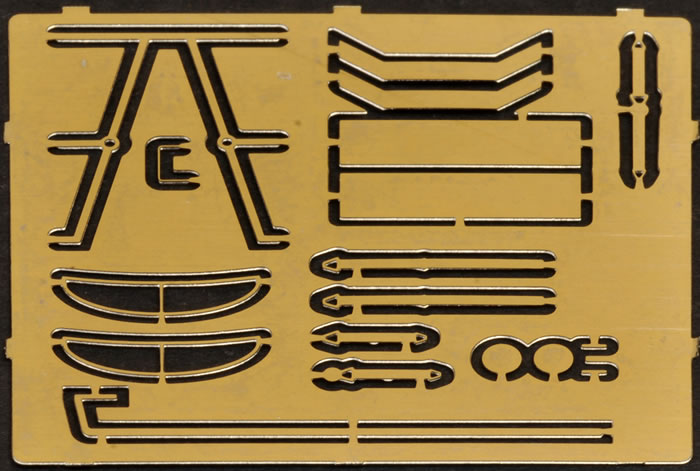
These cockpits are enclosed within fuselage halves that have delicate engine cowl louvers and nicely done fabric effect with prominent longerons, as per the original.
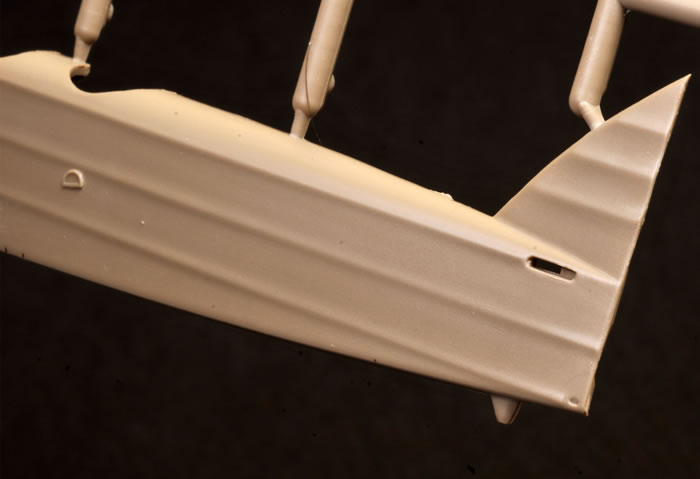
It is necessary to remove the ventral cowl panel and replace it with an alternate kit part featuring more louvers. It is also necessary to ensure you select the correct radiator front for the cowl as a choice of two styles is provided.
The fuselage features a separate rudder and tailplane with elevators fixed in the neutral position. This is supported by bracing struts either side between the fuselage and its underside.
There are a few items left to add to the fuselage, including the rear gunner’s gun-ring in the case of the first production machine use for PR purposes (without paired guns), a tail-skid, and oil cooler under the cowl. There is a choice of propellers, a bent metal style made of resin for the Prague-Tokyo machine, or a wooden style in styrene for the production machine. Of course there is also the undercarriage to mention whose legs have small locating lugs to match corresponding holes in the fuselage.
There are some small PE items for the fuselage, and like the gun-ring (if applicable) are probably best left until late in the build process. They include two circular plates with a protruding rail-step to replace the moulded half-circle boarding steps, windscreen frames to which the clear acetate screens must be cut out and carefully glued in place, and a small hooped boarding step.
As with the fuselage, the fabric effect on the wings is nicely done. Although a limited-run kit, it does feature small mounting tabs for the lower wings to slot into the fuselage, which should ensure adequate strength to the join. Both lower and upper wings have small locating holes for the struts with their fine pins to locate within. As with all biplanes, care will be needed when fitting the upper wing, but this job is made a little easier by the S-16’s absence of wing stagger and lack of dihedral. The ailerons on the upper wing feature small secondary airfoils mounted above; I doubt that these served any servo-type purpose, but I really have no idea. Anyway, they are made from folded PE parts. There are also tie-rods between the upper and lower ailerons to fit
A PE pitot is provided to mount the starboard interplane struts in the case of the production version. However, this is rather flat and unconvincing, and may serve better as a pattern for a three-dimensional scratch-built item. The instructions seem a little vague on positioning this pitot to me. Having checked photos, I see it should mount horizontally about a 30% of the way down the interplane struts, with its rear end against the rear strut, and fixes to the inner side nearest the fuselage (unlike the images of the assembled model from Brengun’s website that show it fixed on the outside of the struts).
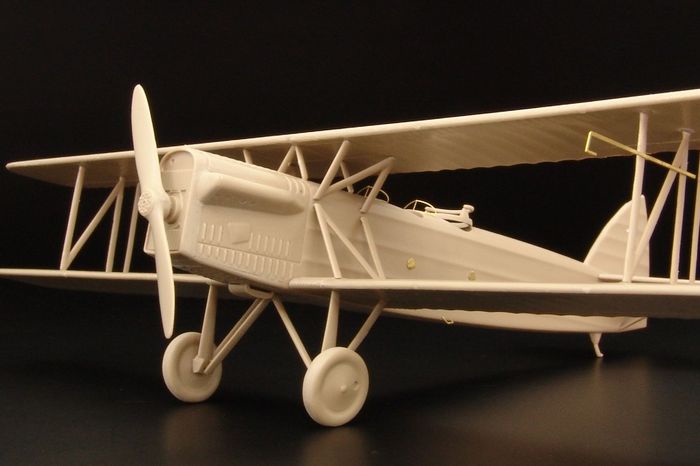
Building this boxing’s primary version looks to b e quite simple as biplane kits go, with only about 40 styrene parts, plus the lack of wing stagger and dihedral. Of course, the PE items may add some fiddley moments, with the windscreens needing particular care; but in general, I would anticipate that this kit should build well.
Brengun obviously plan other versions as evidenced by the bombs and other parts in this review sample, and their own promotional images for their S-16 PE detail set.
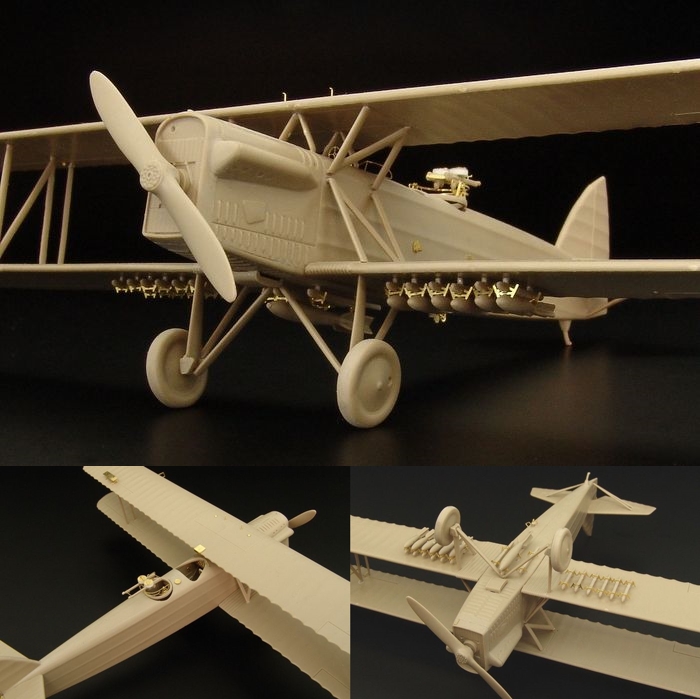
Colours and Markings
The two machines covered by this boxing have been described already, and are very similar as the colours and markings illustration from the box illustrates:
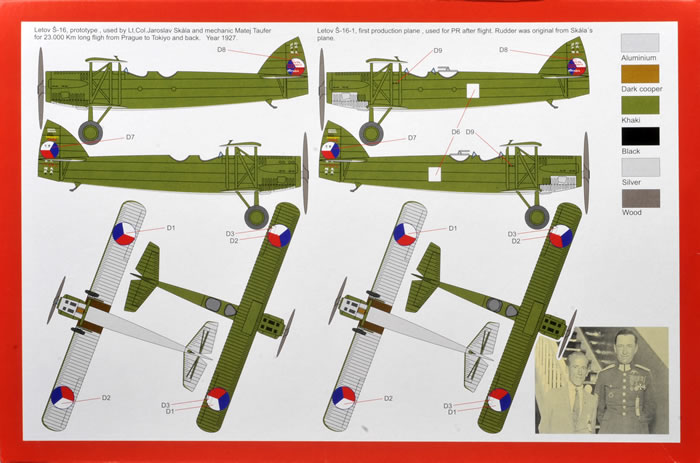
This is a welcome kit of an important Czechoslovak type. I am sure we will see it in further boxings, obviously as a bomber and reconnaissance machine in Czechoslovak markings, and perhaps Latvian and Turkish insignia too.
This boxing is surely pitched mainly at the domestic Czech market, and a degree of cynicism suggests to me that Brengun aims to capture sales from those too impatient to wait for the military-service boxings, and so amortise some of this boxing’s production costs across a group not interested in the Prague to Tokyo flight.
Whatever the marketing rationale is behind it, the fact remains that Brengun’s S-16 is very well executed, with excellent quality parts for a limited run kit. So much so that I feel the term “limited-run” has little meaning here. It has without doubt bettered the old and faithful offering by Kovozávody Prostejov (and KP Models/Mastercraft). As such, it is best injected kit of the Letov S-16 in The One True Scale.
I definitely recommend this kit, and look forward to future issues covering other versions.
Thanks to Brengun for the review sample.
Review Text Copyright © 2015 by Mark Davies
Images Copyright © 2015 by Brett Green
Page Created 19 February, 2015
Last updated
19 February, 2015
Back to HyperScale Main Page

|
